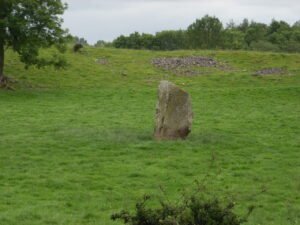Should we take seriously legends about ‘retribution’ coming to humans who violate ritual sites? Robert W E Farrah has been wondering the same thing…
It was during the campaign to stop a Christian ‘Millennium Monument’ being erected in the vicinity of Mayburgh henge (see NE 84 & 85) that I was reminded that my own long-term attraction to these ancient monuments was, like them, invested with what I can only describe as some innate spirituality.
My own focus in that campaign had been archaeoastronomy, but I emphasised that although enabling the researcher ‘to quantify aspects of the ancient landscape, it is inseparable from the wider issues of the sacred and ritual landscape’1. The significance of the astronomical alignments at Mayburgh reaffirmed the importance of a landscape seemingly invested with a cosmic order. The axis of Mayburgh’s orientation was like a nave and chancel centred upon an altar – the altar being the sacred summit of the distant mountain of Blencathra, where the sun sets at the equinox. I suggested that the almost supernatural rising of the mountain from the centre of the henge when approaching Mayburgh from the east seemed to go far beyond practicalities and into the realm of the sacred2. It would seem that these numinous qualities were also a motivating factor for Canon Gervase Markham, who wanted to place the Monument close to Mayburgh to honour the spiritual aspirations of our ancestors3.
Aside from the real issues of the campaign and almost as a footnote, I introduced as a cautionary note the traditions at many of these ancient sites of a presiding protective spirit – an atavistic guardian, or genius loci, which might suddenly be unleashed on any perpetrators of harmful disturbance to a site4, the point being that the issues involved may not be in the sole domain of the tangible and pragmatic issues of the authorities.
Such forces are not easily rationalised within the fixed parameters of planning inspectors. The final decision may not rest with any planning department but lie in another realm altogether, where consultation is not an issue. Canon Markham did respond to this cautionary note of mine. After observing that many of my objections seemed ideological, he stated “He raises the sinister spectre that we shall be haunted by ghosts or struck by a terrible curse…I am old enough to face this danger imperturbably…’5. My final ‘ideological’ response was to reiterate the traditions associated with these sites together with an example of a farmer who died shortly after trying to remove a stone belonging to the Laggangarn standing stones near New Luce (incidentally carved with Latinate crosses around the 8th century in what is thought to be an attempt to Christianise a pagan holy place)6.
Research soon unearthed such a tradition at Mayburgh in connection with the destruction of the central setting of megaliths, recorded in an appendix by Heelis to Clarke’s Survey of the Lakes,1789. Clarke tells that “stones were blasted and removed by order of a person who seems to have been at that time the farmer of this place: one of the men employed in the work having hanged himself, and the other turning lunatic, has given a fair opening to vulgar superstition, to impute these misfortunes to their sacrilege in defacing what they suppose was formerly a place of eminent sanctity”7.
Following debate over the appropriateness of using a prehistoric ritual site for Christian services and commemoration and even over the ritual significance of Mayburgh, it was finally agreed to hold the celebration outside the henge, but at the foot of its cobbled bank in the adjacent field.

So on Sunday, July 2, 2000, just as the sun was reaching its zenith, and several hours before the Right Rev Richard Garrard, Bishop of Penrith, climbed a ladder to the top of the Millennium Monument and blessed the stone, a neo-pagan assembly met at the henge to perform a blessing and to ask the ancestral spirits of Mayburgh to accept the new Millennium Monument into the landscape.
The blessing is an act invoking divine protection. Sacrilege is the desecration of anything regarded as sacred, resulting in the invocation of the darker side of divine protection – the curse. As the Bishop laid hands on the stone in blessing, in the shadow of Mayburgh, he was inadvertently giving substance to the darker legend of the Henge. Indeed a story was unfolding elsewhere within the diocese that would confirm that the church authorities took such occult matters very seriously, questioning Canon Markham’s own seemingly glib response to the traditions of divine intervention and retribution attached to many of our sacred pre-Christian monuments.
NOTES
- Farrah, R W E. ‘Stand-off at Mayburgh Henge’, Northern Earth 84, 2000, p.25
- Farrah, R W E. ‘Mayburgh Henge: A Sacred Space Odyssey’, Northern Earth 85, 2001,p.19
- Cumberland & Westmorland Herald (CWH), 12-Feb-2000. See Note 1
- Farrah, CWH 29-Jan-2000
- Markham. CWH 12-Feb-2000
- Farrah. CWH 18-Mar-2000
- Heelis, Rev.A.J. ‘Maybrough and King Arthur’s Round Table’. Trans Cumberland & Westmorland Antiq & Arch. Soc 12, 1912, p.153
Published in NE91, Autumn 2002, p19-20
https://northernearth.co.uk/subscription-2024/